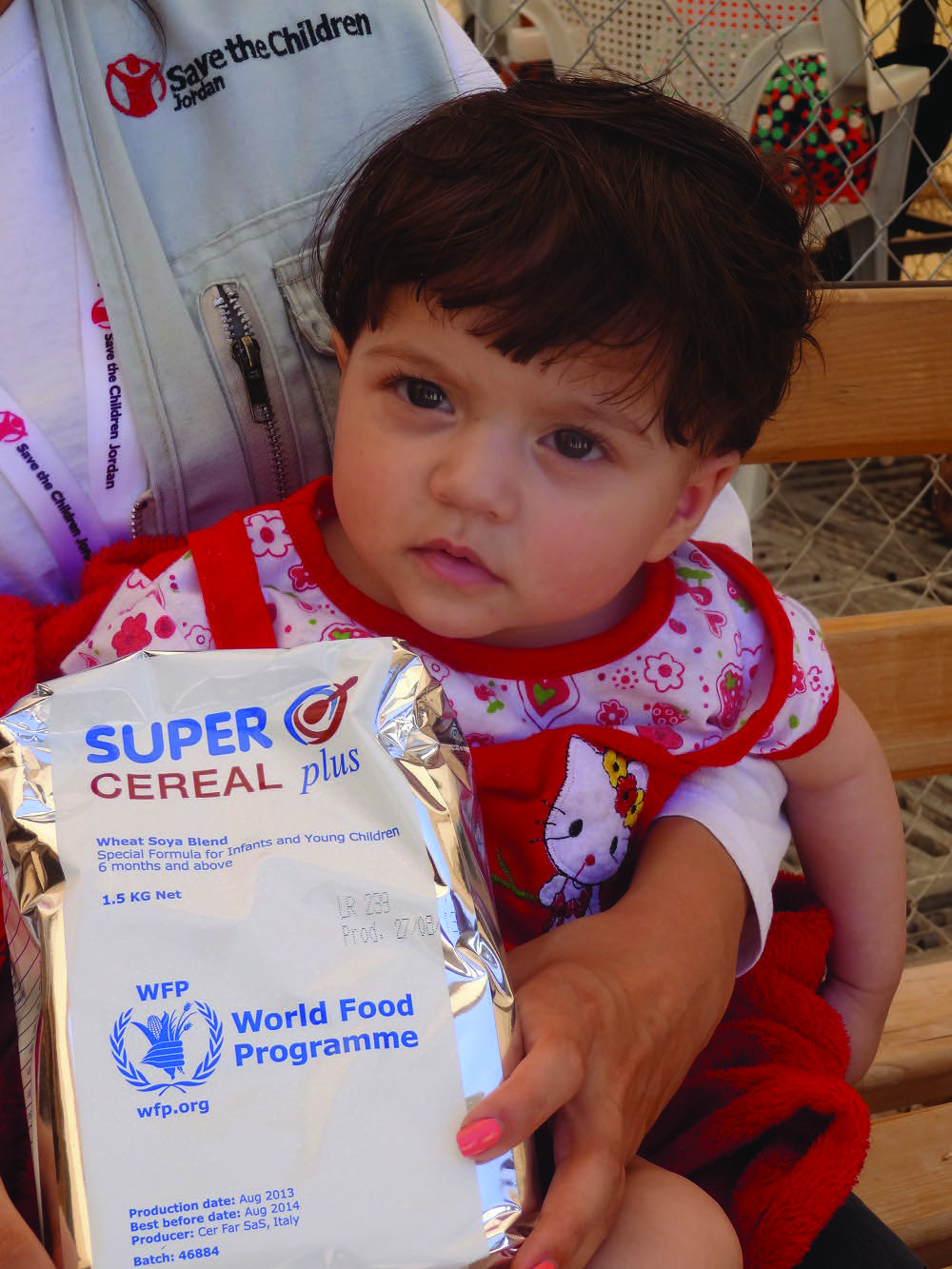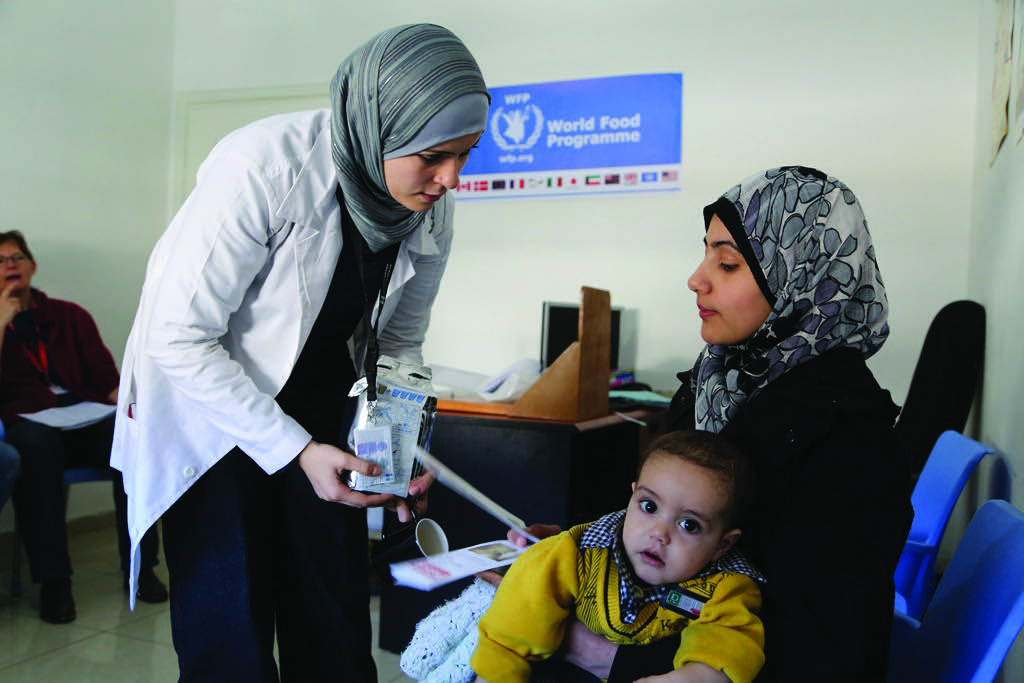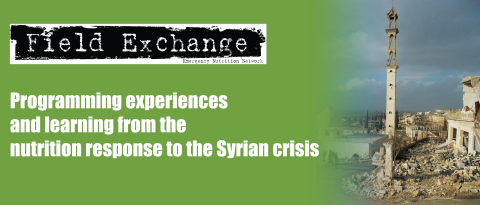Meeting Syrian refugee children and women nutritional needs in Jordan
 By Henry Sebuliba and Farah El-Zubi
By Henry Sebuliba and Farah El-Zubi
Henry Sebuliba is a Nutrition Programme Officer at the World Food Programme Regional Emergency Coordination Unit in Amman, Jordan. A Public Health nutritionist, he has more than 10 years of international experience in nutrition programming in Africa, Asia and the Middle East.
Farah El-Zubi is the Nutrition Programme Officer at the World Food Programme’s Jordan Emergency Operations Unit in Amman, Jordan. Farah also supports coordination of the Food Security Sector in Jordan in addition to managing protection-related matters, and has former experience working with the World Health Organisation’s Iraq Country Office for four years.
 Background
Background
Due to the prolonged and evolving nature of the crisis in Syria many Syrians have sought and continue to seek refuge in neighbouring countries such as Lebanon, Turkey, Iraq, Egypt and Jordan. According to the population figures of the United Nations High Commissioner for Refugees (UNHCR), there are 618,086 registered Syrian refugees in Jordan as of 18 September 20141. Approximately 85% of Syrian refugees in Jordan live within the community, mainly in the governorates of Amman, Mafraq, Irbid and Zarqa. The remaining 15% of the refugee community live in Za’atri and Azraq camps.
Pre crisis data on Syrian refugees indicated a poor nutrition level for children under 5 (CU5) according to World Health Organisation’s thresholds, with an estimated 9.3% wasted, 10.3% underweight and 23% stunted2. Micronutrient deficiencies were also found to be common -(anaemia prevalence was estimated at 29.2%), presenting a risk for sub-optimal growth among CU53.
In order to assess the needs of Syrian refugees in Jordan, WFP and the United Nations Children Fund (UNICEF) conducted the Inter-Agency Nutrition Assessment in November 2012 with the participation of Jordan’s Ministry of Health (MoH), the Department of Statistics (DOS), UNHCR, WHO, the United Nations Population Fund (UNFPA), Save the Children International (SCI) as well as other NGOs. The assessment evaluated the nutrition and food security level of Syrian refugees living in both urban/rural areas and camp settings.
According to the assessment’s findings, Global Acute Malnutrition (GAM or wasting) prevalence rates were found to be 5.8% in camp settings and 5.1% among refugees residing in urban communities4. The assessment also found that 4% of Syrian CU5 and 6.3% of pregnant and nursing women and girls were moderately malnourished and recommended the provision of targeted supplementary feeding support for this category. Consistent with the pre-crisis data the assessment also revealed sub-optimal Infant and Young Child Feeding (IYCF) practices among the refugee community in Jordan; just under half of children below 2 years old (49.6% in the camp and 42.7% in the local community) continued to be breastfed.
 Programme plan and implementation
Programme plan and implementation
As per the recommendations of the 2012 Joint Nutrition Assessment, WFP introduced a Targeted Supplementary Feeding Programme (TSFP) to treat moderately malnourished Syrian children and women both in camps and in urban communities. This was based on the Memorandum of Understanding between WFP and UNHCR in Jordan which stipulates that WFP is responsible for the management and treatment of moderate acute malnutrition (MAM), while UNHCR is responsible for the management of Severe Acute Malnutrition (SAM).
In addition, distribution of SuperCereal Plus was launched in Za’atari camp for children aged 6-23 months to ensure they had access to age-appropriate food considering they are not readily available in Za’atari camp and can only be purchased in pharmacies.
In June 2013, UNHCR started blanket distribution of a locally procured fortified blended food (Sahaa) to all children aged 6-23 months. This was distributed over a period of three months5. In addition, treatment of MAM commenced using the same product until February 2014 when transition to the use of SuperCereal Plus began.
Targeted Supplementary Feeding Programme (TSFP)
Since February 2014, WFP in partnership with Medair, Save the Children Jordan (SCJ) and ACTED have been distributing SuperCereal Plus as part of WFP’s TSFP to treat moderately malnourished CU5 and pregnant and nursing women and girls in both the local communities and camp settings. In February 2014, before the launch of the TSFP programme, SCJ conducted a comprehensive Mid Upper Arm Circumference (MUAC) screening of all CU5 and pregnant and nursing women and girls in Za’atari camp. It took 12 days to complete and a total of 13,009 CU5 were screened, amongst whom 27 SAM cases and 164 MAM cases were found.
In addition, a total of 2,515 pregnant and nursing women and girls were screened, of whom 51 were found to be malnourished. Identified cases were contacted prior to the TSFP enrolment days, however SCJ faced challenges in following up on some of the cases due to redundant mobile phone contacts provided by the beneficiaries. In Za’atari camp, SCJ has also recruited community mobilisers/volunteers who are responsible for conducting routine MUAC screenings. CU5 and pregnant and nursing women and girls diagnosed with MAM are issued referral tokens which they presented at MAM treatment sites and have their anthropometric measurements taken to confirm if they are eligible for enrolment to the TSFP programme.
Moderately malnourished CU5 meeting anthropometric admission criteria (MUAC < 125mm and >= 115mm and no oedema) and pregnant and nursing women and girls with MUAC < 230mm are admitted to the programme. Beneficiaries are provided with a two weeks ration of SuperCereal Plus. Children are provided with a daily ration of 200g/day while pregnant and nursing women and girls receive 250g/day. Follow up visits are conducted every two weeks to replenish SuperCereal Plus supplies, and for beneficiary medical review as well as provision of systematic treatment at health clinics run by the Jordan Health Aid Society (JHAS).
 By the end of May 2014,three months following the roll-out of the WFP nutrition programme, SCJ had reached 223 beneficiaries in Za’atari camp (168 CU5 and 55 pregnant and nursing women and girls) out of the targeted 1,510 beneficiaries (1,154 CU5 and 356 pregnant and nursing women and girls).
By the end of May 2014,three months following the roll-out of the WFP nutrition programme, SCJ had reached 223 beneficiaries in Za’atari camp (168 CU5 and 55 pregnant and nursing women and girls) out of the targeted 1,510 beneficiaries (1,154 CU5 and 356 pregnant and nursing women and girls).
Estimation of the targets was based on the 2012 nutrition survey findings however it appears that nutrition levels had improved. Consequently fewer children with MAM were been identified by WFP partners. Analysis of the performance indicators in the camp reveal that 68% of the target population have been cured, 23% defaulted and 9% transferred to Outpatient Therapeutic Care (OTP).
In both Za’atari and Azraq camps, sensitisation activities are carried out by community volunteers and cooperating partners’ staff prior to distribution of SuperCereal Plus and during follow-up visits, in addition to nutrition education sessions conducted at health clinics in the camps.
WFP supports TSFP implementation in the local community through a partnership with Medair which operates in coordination with the Jordanian Health Aid Society (JHAS) to manage the community component of the programme. Management of acute malnutrition is conducted in each of the six available JHAS health clinics in Amman, Jerash, Ajloun Zarqa, Mafraq and Irbid. The Medair outreach and mobile teams are responsible for screening and referring malnourished children and pregnant and nursing women and girls in the community to JHAS clinics for treatment6. Routine sensitisation of the refugee population is conducted by Medair outreach volunteer teams and through the JHAS clinics7. A total of 215 beneficiaries including 79 children and 140 pregnant and nursing women and girls have been reached to date (June 2014) and out of these 71% have been cured, 22% defaulted and 7% were non responders.
Blanket age-appropriate food assistance
Age-appropriate food support is provided to children aged 6-23 months in the camps. Each child is provided with 100g/day of SuperCereal Plus on a monthly basis. A total of 8,258 CU5 in Za’atari camp received SuperCereal Plus under this programme in May 2014 (target 13,000). WFP, in partnership with ACTED, are also providing supplementary food to all CU5 in Azraq camp. In May 2014, about 456 newly arrived children were reached. This is lower than the target figure of (1266) as a larger case load of new arrivals was anticipated.
Decision-making regarding approach
In Jordan, Syrian refugees receive their food assistance in the form of vouchers provided by WFP which beneficiaries can redeem in WFP’s supermarkets in the camps. However, according to Jordanian law, specialised weaning-foods for young children can only be obtained from pharmacies. This means, that nutritious age-appropriate foods are not available in WFP supermarkets in the camps where beneficiaries redeem their vouchers. Therefore, distribution of SuperCereal Plus rather than food voucher/cash was used for provision of age-appropriate food in camps.
Implementation challenges
Some of the main challenges confronting the implementation of the programmes were related to Syrian refugee children and women’s taste acceptance of SuperCereal Plus. This was a product that they had not used or eaten before. However WFP partners (SCJ, Medair/JHAS and ACTED) addressed this concern by holding sensitisation sessions and awareness campaigns about the use and benefits of SuperCereal Plus. This includes carrying out cooking demonstrations, as well as encouraging beneficiaries to add condiments such as honey, fruits, sugar and salt to make the product tastier. As a result, acceptability increased significantly8.
Ensuring follow-up of moderately acute malnourished children and women, especially in the community, has proven difficult as they cannot be easily traced through mobile phones, either because they have changed their numbers or are no longer in the country and this has contributed to the observed high default rates.
Conclusion
Preliminary results of the follow-up nutrition survey conducted in refugees living in Za’atari camp and the local community between April and May 2014 are suggesting an improvement in acute malnutrition prevalence rates among Syrian refugees community in Jordan. The 2014 survey findings revealed that GAM rates are at 1.2% in Za’atri camp and 0.8% in the local community, a clear improvement in comparison to the 2012 findings. However, it also showed that micronutrient deficiencies have persisted among Syrian refugees, especially those living in camps. Results showed that anaemia prevalence was at 48.7% among CU5 and as high as 64% among children under 2 years. Anaemia levels remain high in girls and women of reproductive age, standing at 44.7%. These results indicate that anaemia prevalence is critically high and a serious public health concern.
Given the low prevalence of acute malnutrition among Syrian refugees in Jordan, there has been a shift in focus to promote optimal nutrition and integrating cultural practices in complementary nutrition support as well as steps towards integrating malnutrition within the national health system. In any case, it will be essential for nutrition stakeholders in Jordan to continue to monitor the nutrition status of Syrian refugees in Jordan as long as the Syria crisis persists.
For more information, contact: Shada Moghraby, WFP Public Information Officer, email: shada.moghraby@wfp.org
1 Source: http://data.unhcr.org/syrianrefugees/country.php?id=107
2 Syrian Family Health Survey (2009)
3 MOH, Nutrition Surveillance System Report 2011
4 Inter- Agency Nutrition assessment Syrian refugees in Jordan host communities and Zaatri camp, 2012
5 It was distributed as a blanket for 3 months but a reduced ration for the third month. See article by Save the Children Jordan that describes this support in more detail.
6 See field article in this edition of Field Exchange (48) describing JHAS programming in Jordan
7 See field article in this edition of Field Exchange (48) describing Medair’s programming in Jordan
8 See field articles by both Medair and Save the Children Jordan explaining aspects of this programme.


